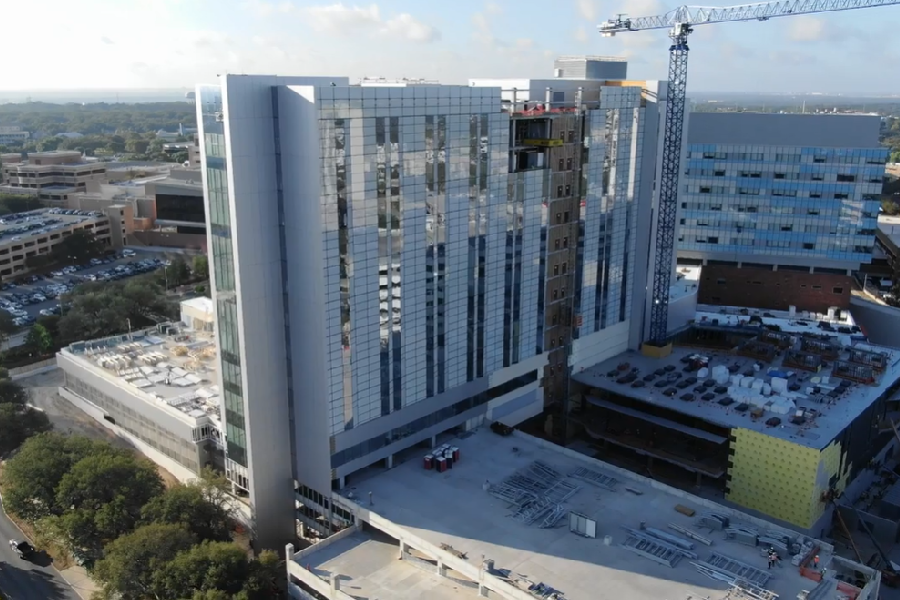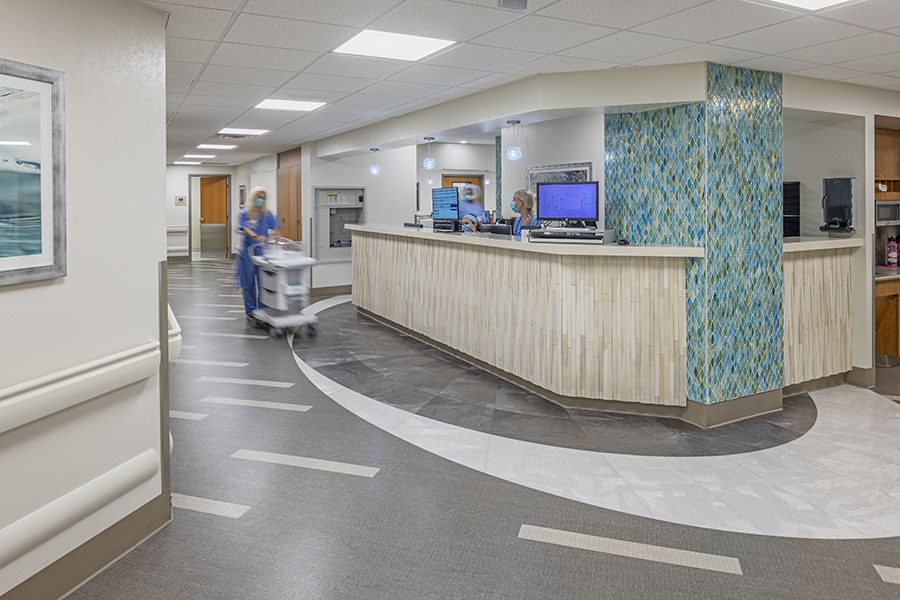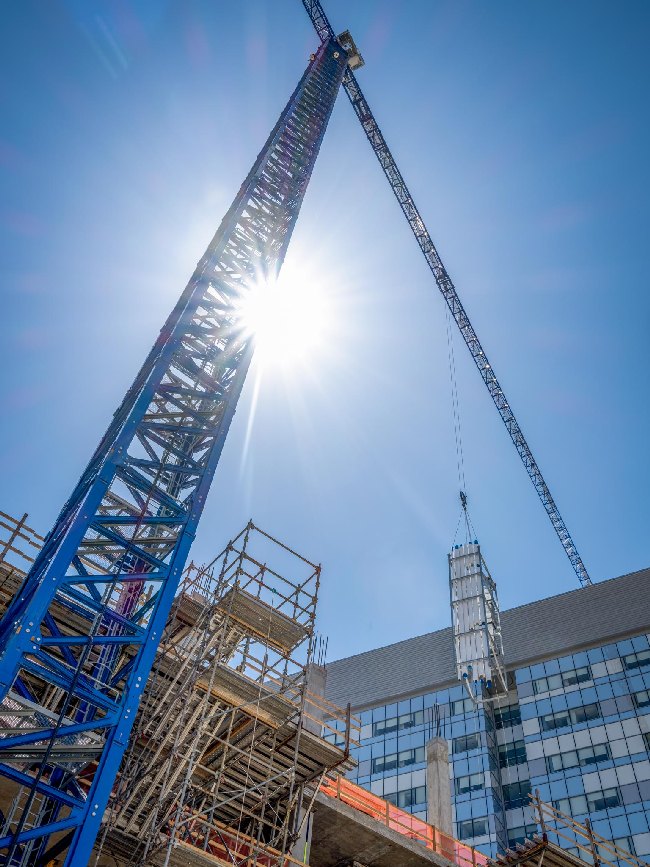 Complex projects like University Health System’s new hospital in San Antonio require a sophisticated approach. Photo DroneDeploy
Complex projects like University Health System’s new hospital in San Antonio require a sophisticated approach. Photo DroneDeploy  The project team tripled the number of construction phases at Rose Medical Center in Denver. Photo Frank Ooms
The project team tripled the number of construction phases at Rose Medical Center in Denver. Photo Frank Ooms Subscribe Now
The Master Planning Journey: Key Strategies to Mitigating Risk & Optimizing Outcomes
By Paul Zubek
As many hospitals shift to what feels like a nearly continuous strategic planning cycle, and focus on an array of dynamic initiatives during a pivotal time in the industry, it’s no surprise multi-year, multi-phase, campus-wide design and construction initiatives are particularly in demand.
Given their potential to impact so many hospital priorities – like the patient experience, market competitiveness, operational and financial performance, innovation, technological advancement and the employee experience – these projects come with greater rewards, but also greater risks, and therefore require more sophistication than shorter, simpler projects.
Unique challenges + intricacies
Multi-year, multi-phase master planning initiatives typically involve several separate but related renovation and expansion projects over the course of several years. So, these projects inevitably require more resources – from the construction manager, design partners, trade partners and owner – to successfully deliver high-quality results within the shortest time possible. But, according to healthcare vice president at JE Dunn Construction, Russell Templin, “anytime more stakeholders are involved, risk and complexity increase.”
Furthermore, since these projects occur over multiple years and the initial design and preconstruction planning phases are typically longer, funding and designs must be more future-proof and flexible. Especially for investments of this magnitude that impact multiple locations within a hospital campus, each phase of the project must remain just as relevant – to demographic needs, clinical best practices, technology advancements, customer preferences, revenue potential and regulatory requirements, for example – upon completion as when they were first envisioned.
Many owners also rely on multiple funding sources for various portions of these projects. For example, revenue generated from a new space might be leveraged to fund a later phase of work. “So, the risk and complexity of estimating, budgeting and funding are closely intertwined and inherently greater on projects like these too,” added JE Dunn’s Healthcare Preconstruction Services Director Sam O’Connor.
There is also more potential for disruption to daily hospital operations than with a typical construction project, since master plan initiatives impact many areas of a campus over several years. This warrants more sophisticated phasing and logistics plans to ensure business continuity in numerous areas of each impacted facility, plus loading docks, utilities, parking, patient entrances, ambulances, helipads and the like.
Given the increased difficulty and potential pitfalls associated with master planning initiatives, leveraging specific strategies and engaging the right team early in the project can significantly reduce those risks and positively impact the multi-year journey to completion.
Comprehensive preconstruction planning

Successful preconstruction planning for master planning initiatives must ensure logistics, safety, phasing and scheduling plans minimize risk and impact to the hospital’s daily operations. Photo: Andy Luten
All successful construction projects are founded on good planning and preparedness, but more complex, extensive preconstruction planning is necessary for master plan initiatives. “Today’s preconstruction services must go beyond estimating,” said Templin. Ideally, preconstruction planning should also encompass considerations like logistics, safety, phasing, scheduling, Lean management, communications and virtual design and construction. “When done well, these ‘pre-building’ services are there to mitigate risk and provide the best chance of impacting outcomes before construction ever begins,” adds Templin.
Preconstruction planning founded on a culture of collaboration, coupled with early involvement of key stakeholders, is critical to master planning success. O’Connor believes this culture of collaboration starts with effectively listening to all stakeholders – owner, contractor, design and trade partners – “because a good plan won’t truly be comprehensive unless it accounts for each stakeholder’s concerns and priorities from the very beginning.”
Likewise, involving key parties as early as possible is just as important for productive communication and teamwork throughout the project. “Having the main players involved during design on University Health System’s new Women’s and Children’s Hospital project in San Antonio (Texas) helped foster the collaboration, trust and accountability needed for the alignment, agility and success that carried through design and into construction.”
Especially in today’s dynamic economy, a more sophisticated approach to budgeting and estimating projects is also imperative for success during preconstruction. These multi-year budgets must account for year-over-year phasing and escalation, and contractors must be able to quickly articulate how budgets are changing relative to the other moving parts of the design and planning process. “Since these budgets need to hold true for multiple years and projects, we must be nimble enough to provide almost real-time pricing analyses as needs, designs and the market change,” advised O’Connor. This level of agility and precision requires close collaboration between design, construction and trade partners to ensure each piece of the puzzle remains aligned from one design and budget iteration to the next. “This allows owners to have all the facts needed to quickly make informed decisions by enhancing transparency and building trust throughout the planning process,” he added.
Successful preconstruction planning ensures all logistics, safety, phasing and scheduling plans minimize the impact to hospital operations and the patient experience as much as possible. For example, Adam Riggs, JE Dunn healthcare project manager at Rose Medical Center, explained, “We tripled the typical number of construction phases to ensure we minimized the impacts on the hospital’s patients and daily business as much as possible.”
Communication + collaboration = high-performing teams
Effective multi-year efforts also necessitate particularly adept leadership and an equally strong team. Since key stakeholders must work together for multiple years to complete the project, exceptional collaboration, trust and leadership are even more essential than on shorter projects. Similarly, every subset of the team needs strong leadership too. “On smaller projects, a team might be able to compensate for one weak link,” explained O’Connor. “But you can’t claw your way through a big project for three to seven years. Teams just can’t recover if each stakeholder’s key players aren’t strong enough and consistently in sync with each other.”
These projects, like the extensive master planning initiative underway at Swedish Medical Center in Denver, Colorado, occur over the course of years rather than months and construction plans are subject to the hospital’s daily operations and could change at a moment’s notice. So, successful project leaders must also be nimble and flexible. “We always have detailed plans when we start jobs like these, but how we get there will inevitably change,” elaborated JE Dunn’s healthcare general superintendent at Swedish, Adam Gross. “Being able to adapt is critical.”
To that end, fostering strong, authentic relationships with the hospital’s key stakeholders is also essential to keeping the lines of communication open, adapting and preventing surprises. “Being able to pick up the phone and quickly discuss changes and challenges so the facility is never caught off guard, and so we can get the information we need about the hospital’s operational plans, current census, daily surgical schedules and other key details is invaluable to keeping these projects on schedule,” shared Gross.
Foster strong + lasting partnerships
Perhaps most importantly, master planning teams should foster strong partnerships with the hospital and other stakeholders in a way that extends beyond the letter and scope of contractual obligations and plans. The stakes are inevitably higher on these types of initiatives, but with the right leaders, solid partnerships and smart plans, success is sure to follow. “The wrong team can wear out their welcome pretty quickly on projects like these, especially because so many areas of the hospital are impacted over several years,” explained Gross. “But good contractors see themselves as an extension of the hospital and will jump in to help solve problems and make the client’s life easier. It’s just the right thing to do as a good, long-term business partner.”
Author: Paul Zubek
Paul Zubek is senior healthcare project manager at JE Dunn Construction.
Tags: Construction, Master Planning, preconstruction
Posted November 16, 2022
More Articles:
- World Conference on Quality & Improvement
May 12, 2024 – May 15, 2024 - ACEC Annual Convention & Legislative Summit 2024
May 13, 2024 – May 16, 2024 - 2024 Annual Clinical & Scientific Meeting
May 17, 2024 – May 19, 2024 - CleanMed 2024
May 21, 2024 – May 23, 2024 - Hospital, Outpatient Facilities & Medical Office Buildings Summit
May 22, 2024 – May 22, 2024 - HealthSpaces
Jun 2, 2024 – Jun 4, 2024 - Hospital, Outpatient Facilities & Medical Office Buildings Summit
Jun 6, 2024 – Jun 6, 2024










